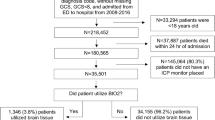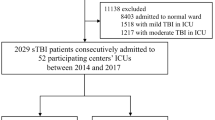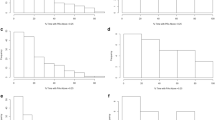Abstract
Introduction
Intracranial pressure (ICP) monitoring and cerebral perfusion pressure (CPP) management are the current standards to guide care of severe traumatic brain injury (TBI). However, brain hypoxia and secondary brain injury can occur despite optimal ICP and CPP. In this study, we used brain tissue oxygen tension (PbtO2) monitoring to examine the association between multiple patient factors, including PbtO2, and outcome in pediatric severe TBI.
Materials and methods
In this prospective observational study, 52 children (less than 15 years) with severe TBI were managed with continuous PbtO2 and ICP monitoring. The relationships between outcome [Glasgow Outcome Score (GOS) and Pediatric Cerebral Performance Category Scale] and clinical, radiologic, treatment, and physiological variables, including PbtO2, were examined using multiple logistic regression analysis.
Results
Outcome was favorable in 40 patients (77%) and unfavorable (mortality, 9.6%; n = 5) in 12 (23%). In univariate analysis, the following variables had a significant association with unfavorable outcome: initial GCS, computed tomography classification, ICPpeak, mICP24, mICP, CPPlow, CPP<40, pupil reactivity, \({\text{PbtO}}_{2_{{\text{low}}} } \), PbtO2 < 5 mmHg, PbtO2 < 10 mmHg, \({\text{mPbtO}}_{{\text{2}}_{{\text{24}}} } \), and time–severity product. PbtO2 parameters had the strongest independent association with poor outcome in multiple regression analysis. In particular, when PbtO2 was <5 mmHg for >1 h, the adjusted OR for poor outcome was 27.4 (95% confidence interval, 1.9–391). No variables apart from PbtO2 were independently associated with mortality when controlled for PbtO2.
Conclusion
Reduced PbtO2 is shown to be an independent factor associated with poor outcome in pediatric severe TBI in the largest study to date. It appears to have a stronger association with outcome than conventionally evaluated measures.
Similar content being viewed by others
References
Adelson PD, Bratton SL, Carney NA, Chesnut RM, du Coudray HE, Goldstein B, Kochanek PM, Miller HC, Partington MD, Selden NR, Warden CR, Wright DW, American Association for Surgery of Trauma, Child Neurology Society, International Society for Pediatric Neurosurgery, International Trauma Anesthesia and Critical Care Society, Society of Critical Care Medicine, World Federation of Pediatric Intensive and Critical Care Societies (2003) Guidelines for the acute medical management of severe traumatic brain injury in infants, children, and adolescents. Chapter 1: Introduction. Pediatr Crit Care Med 4(3 Suppl):S2–S4
Adelson PD, Bratton SL, Carney NA, Chesnut RM, du Coudray HE, Goldstein B, Kochanek PM, Miller HC, Partington MD, Selden NR, Warden CR, Wright DW, American Association for Surgery of Trauma, Child Neurology Society, International Society for Pediatric Neurosurgery, International Trauma Anesthesia and Critical Care Society, Society of Critical Care Medicine, World Federation of Pediatric Intensive and Critical Care Societies (2003) Guidelines for the acute medical management of severe traumatic brain injury in infants, children, and adolescents. Chapter 6. threshold for treatment of intracranial hypertension. Pediatr Crit Care Med 4(3 Suppl):S25–S27
Bouma GJ, Muizelaar JP, Stringer WA, Choi SC, Fatouros P, Young HF (1992) Ultra-early evaluation of regional cerebral blood flow in severely head-injured patients using xenon-enhanced computerized tomography. J Neurosurg 77(3):360–368
Chesnut RM, Marshall LF, Klauber MR, Blunt BA, Baldwin N, Eisenberg HM, Jane JA, Marmarou A, Foulkes MA (1993) The role of secondary brain injury in determining outcome from severe head injury. J Trauma 34(2):216–222
Figaji AA, Fieggen AG, Argent AC, Leroux PD, Peter JC (2008) Does adherence to treatment targets in children with severe traumatic brain injury avoid brain hypoxia? A brain tissue oxygenation study. Neurosurgery 63(1):83–91 (discussion 91–92)
Fiser DH (1992) Assessing the outcome of pediatric intensive care. J Pediatr 121(1):68–74
Fiser DH, Long N, Roberson PK, Hefley G, Zolten K, Brodie-Fowler M (2000) Relationship of pediatric overall performance category and pediatric cerebral performance category scores at pediatric intensive care unit discharge with outcome measures collected at hospital discharge and 1- and 6-month follow-up assessments. Crit Care Med 28(7):2616–20
Flynn EP, Auer RN (2002) Eubaric hyperoxemia and experimental cerebral infarction. Ann Neurol 52(5):566–572
Graham DI, Ford I, Adams JH, Doyle D, Teasdale GM, Lawrence AE, McLellan DR (1989) Ischaemic brain damage is still common in fatal non-missile head injury. J Neurol Neurosurg Psychiatry 52(3):346–350
Gupta AK, Hutchinson PJ, Al-Rawi P, Gupta S, Swart M, Kirkpatrick PJ, Menon DK, Datta AK (1999) Measuring brain tissue oxygenation compared with jugular venous oxygen saturation for monitoring cerebral oxygenation after traumatic brain injury. Anesth Analg 88(3):549–553
Hlatky R, Valadka AB, Goodman JC, Contant CF, Robertson CS (2004) Patterns of energy substrates during ischemia measured in the brain by microdialysis. J Neurotrauma 21(7):894–906
Hlatky R, Valadka AB, Gopinath SP, Robertson CS (2008) Brain tissue oxygen tension response to induced hyperoxia reduced in hypoperfused brain. J Neurosurg 108(1):53–58
Jennett B, Bond M (1975) Assessment of outcome after severe brain damage. Lancet 1(7905):480–484
Johnston AJ, Steiner LA, Chatfield DA, Coles JP, Hutchinson PJ, Al-Rawi PG, Menon DK, Gupta AK (2004) Effect of cerebral perfusion pressure augmentation with dopamine and norepinephrine on global and focal brain oxygenation after traumatic brain injury. Intensive Care Med 30(5):791–797
Kiening KL, Unterberg AW, Bardt TF, Schneider GH, Lanksch WR (1996) Monitoring of cerebral oxygenation in patients with severe head injuries: brain tissue PO2 versus jugular vein oxygen saturation. J Neurosurg 85(5):751–757
Lang EW, Mulvey JM, Mudaliar Y, Dorsch NW (2007) Direct cerebral oxygenation monitoring–a systematic review of recent publications. Neurosurg Rev 30(2):99–106 (discussion 106–107)
Maloney-Wilensky E, Gracias V, Itkin A, Hoffman K, Bloom S, Yang W, Christian S, Le Roux P (2009) Brain tissue oxygen and outcome after severe traumatic brain injury: A systematic review. Crit Care Med (in press)
Marshall LF, Bowers Marshall S, Klauber MR et al (1991) A new classification of head injury based on computerized tomography. J Neurosurg 75:S14–S20
Meixensberger J, Jaeger M, Vath A, Dings J, Kunze E, Roosen K (2003) Brain tissue oxygen guided treatment supplementing ICP/CPP therapy after traumatic brain injury. J Neurol Neurosurg Psychiatry 74(6):760–764
Menon DK, Coles JP, Gupta AK, Fryer TD, Smielewski P, Chatfield DA, Aigbirhio F, Skepper JN, Minhas PS, Hutchinson PJ, Carpenter TA, Clark JC, Pickard JD (2004) Diffusion limited oxygen delivery following head injury. Crit Care Med 32(6):1384–1390
Narotam PK, Burjonrappa SC, Raynor SC, Rao M, Taylon C (2006) Cerebral oxygenation in major pediatric trauma: Its relevance to trauma severity and outcome. J Pediatr Surg 41(3):505–513
Nortje J, Gupta AK (2006) The role of tissue oxygen monitoring in patients with acute brain injury. Br J Anaesth 97(1):95–106
Palzur E, Vlodavsky E, Mulla H, Arieli R, Feinsod M, Soustiel JF (2004) Hyperbaric oxygen therapy for reduction of secondary brain damage in head injury: an animal model of brain contusion. J Neurotrauma 21(1):41–48
Pigula FA, Wald SL, Shackford SR, Vane DW (1993) The effect of hypotension and hypoxia on children with severe head injuries. J Pediatr Surg 28(3):310–314 (discussion 315–316)
Rossi S, Balestreri M, Spagnoli D, Bellinzona G, Valeriani V, Bruzzone P, Maestri M, Stocchetti N (2000) Oxygen delivery and oxygen tension in cerebral tissue during global cerebral ischaemia: a swine model. Acta Neurochir Suppl 76:199–202
Scheufler KM, Lehnert A, Rohrborn HJ, Nadstawek J, Thees C (2004) Individual value of brain tissue oxygen pressure, microvascular oxygen saturation, cytochrome redox level, and energy metabolites in detecting critically reduced cerebral energy state during acute changes in global cerebral perfusion. J Neurosurg Anesthesiol 16(3):210–219
Scheufler KM, Rohrborn HJ, Zentner J (2002) Does tissue oxygen-tension reliably reflect cerebral oxygen delivery and consumption? Anesth Analg 95(4):1042–1048
Simpson D, Reilly P (1982) Pediatric coma scale. Lancet 2(8295):450
Singhal AB, Benner T, Roccatagliata L, Koroshetz WJ, Schaefer PW, Lo EH, Buonanno FS, Gonzalez RG, Sorensen AG (2005) A pilot study of normobaric oxygen therapy in acute ischemic stroke. Stroke 36(4):797–802
Singhal AB, Dijkhuizen RM, Rosen BR, Lo EH (2002) Normobaric hyperoxia reduces MRI diffusion abnormalities and infarct size in experimental stroke. Neurology 58(6):945–952
Slater A, Shann F, Pearson G, Paediatric Index of Mortality (PIM) Study Group (2003) PIM2: A revised version of the paediatric index of mortality. Intensive Care Med 29(2):278–285
Stiefel MF, Spiotta A, Gracias VH, Garuffe AM, Guillamondegui O, Maloney-Wilensky E, Bloom S, Grady MS, LeRoux PD (2005) Reduced mortality rate in patients with severe traumatic brain injury treated with brain tissue oxygen monitoring. J Neurosurg 103(5):805–811
Stiefel MF, Udoetuk JD, Spiotta AM, Gracias VH, Goldberg A, Maloney-Wilensky E, Bloom S, Le Roux PD (2006) Conventional neurocritical care and cerebral oxygenation after traumatic brain injury. J Neurosurg 105(4):568–575
Stiefel MF, Udoetuk JD, Storm PB, Sutton LN, Kim H, Dominguez TE, Helfaer MA, Huh JW (2006) Brain tissue oxygen monitoring in pediatric patients with severe traumatic brain injury. J Neurosurg 105(4 Suppl):281–286
Tepas JJ 3rd, Ramenofsky ML, Mollitt DL, Gans BM, DiScala C (1988) The pediatric trauma score as a predictor of injury severity: an objective assessment. J Trauma 28(4):425–429
Tolias CM, Reinert M, Seiler R, Gilman C, Scharf A, Bullock MR (2004) Normobaric hyperoxia-induced improvement in cerebral metabolism and reduction in intracranial pressure in patients with severe head injury: a prospective historical cohort-matched study. J Neurosurg 101(3):435–444
Valadka AB, Goodman JC, Gopinath SP, Uzura M, Robertson CS (1998) Comparison of brain tissue oxygen tension to microdialysis-based measures of cerebral ischemia in fatally head-injured humans. J Neurotrauma 15(7):509–519
Valadka AB, Gopinath SP, Contant CF, Uzura M, Robertson CS (1998) Relationship of brain tissue PO2 to outcome after severe head injury. Crit Care Med 26(9):1576–1581
van den Brink WA, Haitsma IK, Avezaat CJ, Houtsmuller AB, Kros JM, Maas AI (1998) Brain parenchyma/pO2 catheter interface: a histopathological study in the rat. J Neurotrauma 15(10):813–824
van den Brink WA, van Santbrink H, Steyerberg EW, Avezaat CJ, Suazo JA, Hogesteeger C, Jansen WJ, Kloos LM, Vermeulen J, Maas AI (2000) Brain oxygen tension in severe head injury. Neurosurgery 46(4):868–876 (discussion 876–878)
van Santbrink H, Maas AI, Avezaat CJ (1996) Continuous monitoring of partial pressure of brain tissue oxygen in patients with severe head injury. Neurosurgery 38(1):21–31
van Santbrink H, vd Brink WA, Steyerberg EW, Carmona Suazo JA, Avezaat CJ, Maas AI (2003) Brain tissue oxygen response in severe traumatic brain injury. Acta Neurochir (Wien) 145(6):429–438 (discussion 438)
Zauner A, Doppenberg EM, Woodward JJ, Choi SC, Young HF, Bullock R (1997) Continuous monitoring of cerebral substrate delivery and clearance: Initial experience in 24 patients with severe acute brain injuries. Neurosurgery 41(5):1082–1091 (discussion 1091–1093)
Zhou Z, Daugherty WP, Sun D, Levasseur JE, Altememi N, Hamm RJ, Rockswold GL, Bullock MR (2007) Protection of mitochondrial function and improvement in cognitive recovery in rats treated with hyperbaric oxygen following lateral fluid-percussion injury. J Neurosurg 106(4):687–694
Acknowledgements
Dr Figaji has received a grant from the South African–Swedish Links Programme (SIDA, National Research Foundation). Drs Figaji and Le Roux have also received a grant from the Integra Foundation for the study of cerebral perfusion pressure thresholds in children.
Author information
Authors and Affiliations
Corresponding author
Rights and permissions
About this article
Cite this article
Figaji, A.A., Zwane, E., Thompson, C. et al. Brain tissue oxygen tension monitoring in pediatric severe traumatic brain injury. Childs Nerv Syst 25, 1325–1333 (2009). https://doi.org/10.1007/s00381-009-0822-x
Received:
Published:
Issue Date:
DOI: https://doi.org/10.1007/s00381-009-0822-x




